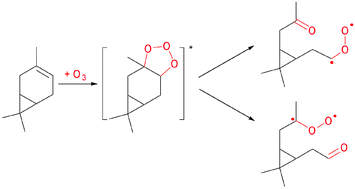Mechanisms for the formation of organic acids in the gas-phase ozonolysis of 3-carene†
Abstract
This paper describes experimental studies aimed at elucidating mechanisms for the formation of low-volatility

* Corresponding authors
a Department of Environmental Science and Engineering, Nanjing University of Information Science & Technology, China
b
Department of Chemistry, Reading University, Whiteknights, PO Box 224, UK
E-mail:
g.marston@rdg.ac.uk
Fax: +44 118 3788703
Tel: +44 118 3786343
This paper describes experimental studies aimed at elucidating mechanisms for the formation of low-volatility

 Please wait while we load your content...
Something went wrong. Try again?
Please wait while we load your content...
Something went wrong. Try again?
Y. Ma, R. A. Porter, D. Chappell, A. T. Russell and G. Marston, Phys. Chem. Chem. Phys., 2009, 11, 4184 DOI: 10.1039/B818750A
To request permission to reproduce material from this article, please go to the Copyright Clearance Center request page.
If you are an author contributing to an RSC publication, you do not need to request permission provided correct acknowledgement is given.
If you are the author of this article, you do not need to request permission to reproduce figures and diagrams provided correct acknowledgement is given. If you want to reproduce the whole article in a third-party publication (excluding your thesis/dissertation for which permission is not required) please go to the Copyright Clearance Center request page.
Read more about how to correctly acknowledge RSC content.
 Fetching data from CrossRef.
Fetching data from CrossRef.
This may take some time to load.
Loading related content
